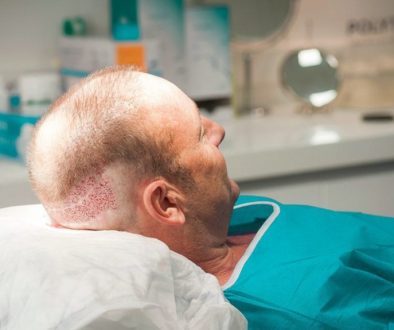Hair Transplant Photos – Parallel (Sagital) Versus Perpendicular (Lateral/Coronal) Slits – ISHRS Live Surgery Workshop 2006
This insightful article was written by well respected hair restoration forum member “Janna” who is also the lead hair transplant technician for Shapiro Medical Group of who is a well respected member of the Coalition of Independent Hair Restoration Physicians.
Two types of incisions one great hair restoration result at nine months.
A while ago Pat Hennessy, the Publisher of the Hair Transplant Network, the Hair Loss Learning Center, and the Hair Loss Q&A Blog inquired about hair transplant photos where Dr. Jerry Wong and Dr. Ron Shapiro were asked to perform a live hair transplant surgery demonstration at the 2006 ISHRS (International Society of Hair Restoration Surgeons) Live Surgery Workshop. Pat asked if I could aid in getting some postoperative hair transplant photos of this particular hair transplant patient. The main objective of the live hair transplant procedure was to showcase a side by side demonstration of sagital and coronal (lateral) incisions while dense packing the hairline. The demonstration went extremely well, so well in fact that both hair transplant surgeons were asked repeat this educational demonstration again at the 2007 European Conference in Paris last May.
Since Dr. Shapiro went through the trouble of putting the hair transplant pictures together for great side by side comparison, I thought there may be seeking hair loss sufferers interested in seeing if they can tell a difference between sides. Most of the hair restoration physicians that have seen the photo as well as Dr. Wong and Dr. Shapiro feel that both sides look very good. I think it demonstrates that as long as fine follicular unit grafts and tiny incision are used properly, the great majority of hair transplant clinical results are due to the skill of the hair transplant physicians rather than a specific incision type. All parties have consented to showing the pictures on the hair restoration forum.
At Shapiro Medical Group, Dr. Shapiro uses both sagital and coronal incisions. Most of the time he uses sagital incisions for the hairline. For him he finds them useful for following the rapidly changing direction of hairs in hairline cowlicks as well as the temporal corners. With the newer tinier blades used to make sagital incisions it is easy to keep the exit angle of hair between-15 to 30 degree. With the newer tinier blades it is also not hard to make sagital incisions at densities ranging from 30-60+ follicular units per square cm especially with 1 hair follicular unit grafts. However, Dr Shapiro will switch to coronals when he does temporal points where the angle of exit needs to be very flat (less than 15 degree). He will also, (depending on the clinical situation) use coronal incisions in the central core region. His decision whether or not to use coronal vs. sagital in the central area if is based on a number of factors but primarily is based on the amount of pre-existing hair a hair restoration patient has and whether or not the patient will agree to shaving the recipient area. If a hair transplant patient has a lot of pre-existing hair at risk for shock loss and will not shave his hair then Dr Shapiro prefers to use sagitals as it is a little easier for him to get in-between existing natural hair with sagitals.
It is interesting that the same Cutting Edge Machine developed by Hasson and Wong to create the tiny customized chisel blades that have been so helpful in making coronal incisions so successful have also enabled the creation of tinier customized angled blades that make the sagital incisions better than before. I mentioned to Dr Shapiro that I was going to post this case and he told me to make sure I mentioned his great respect for both Dr Wong and Dr Hasson as far as their great hair transplant clinical results and the innovations and new ideas that have added to the field of hair restoration.
As far as my opinion so far with respect to the hair transplant results produced with different incisions: I’ve expressed in the past that when viewing follow-up hair transplant patients after a year, it’s very hard to differentiate the two types of incisions when all is said and done. In the hands these two highly respected hair transplant doctors, what becomes more crucial is the angle and artistry of the incisions rather than whether the incisions are perpendicular or parallel. I’ve planted both types for Dr. Shapiro and now I’ve planted in Dr. Wong’s incisions on three occasions and find that either type of incision is fine. What I don’t find is that just because a hair transplant doctor may be exclusive to one type that it’s superior over the other. It’s more about the doctor and how they utilize their skills in making the incisions.
—
Bill
Associate Publisher
Technorati Tags: hair transplant, hair restoration, hair transplant photos, hair transplant surgery, ISHRS, International Society of Hair Restoration Surgeons, hair transplant patient, hair transplant procedure, dense pack, hair transplant pictures, hair restoration physician, Dr. Wong, Dr. Shapiro, follicular unit grafts, hair transplant clinic, coronal incision, sagital incisions, follicular unit, hair restoration patient, natural hair, hair transplant doctor



